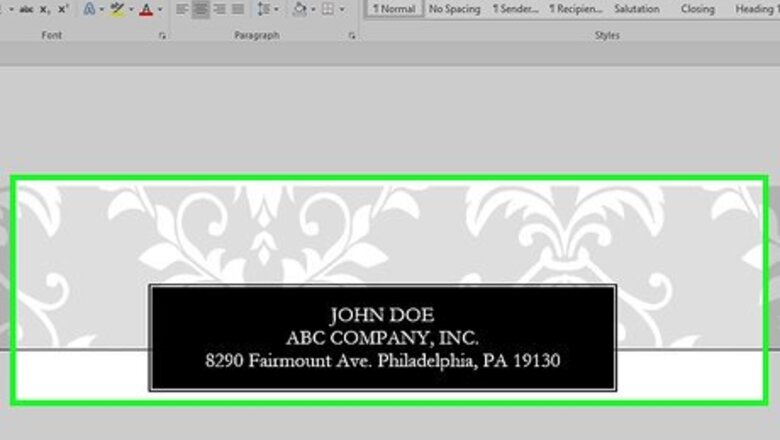
views
Formatting Your Letter
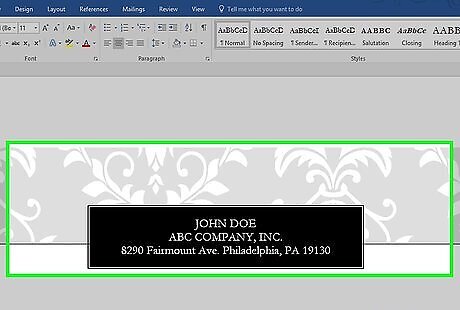
Use letterhead if you have it. Particularly if you are writing your letter in a professional capacity, letterhead from your company or firm is preferred for a letter of attestation. Don't use company letterhead, however, if you're writing in your personal capacity. For example, if you're writing an attestation letter for a former employee to attest to their skills and expertise, you would want to use company letterhead. If you're writing an attestation letter for yourself, don't use company letterhead if the subject of the letter has nothing to do with your work for the company.
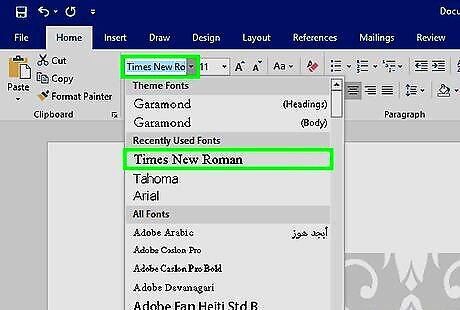
Choose a readable font. For an attestation letter, you typically want to use a more formal, conservative font such as Times New Roman. This font is available on any word processing application. You can also use a default font, such as Arial or Helvetica.
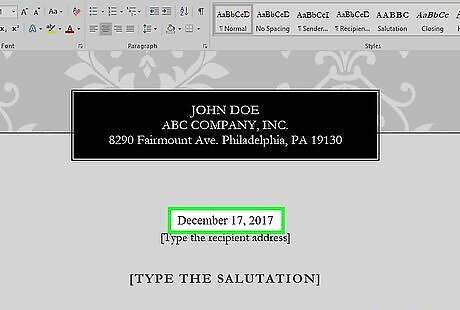
Date your letter. The top line of your letter should be the date you are writing the letter. You may want to post date the letter if you don't think you're going to be able to mail it for a day or two. Write out the month rather than using numerals. If you're using a business letter template through your word processing application, it may insert the current date by default.
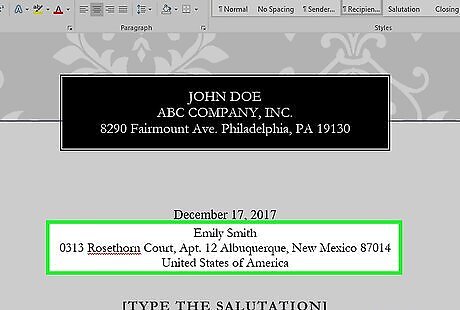
Include the address of the recipient. Include the full name of the recipient, if known, and their job title. If you're simply writing your letter to a school, company, or professional board, the name of the entity is sufficient. Addresses on business letters are typically done in block format, similar to the way you would write them on an envelope. If you're using a template from your word processing app, it will already have these text boxes set up for you. If you're not using letterhead, the first block on your letter would be your name and address. You would then follow with the recipient's name and address.
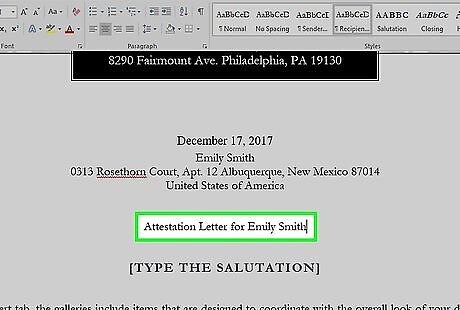
Provide a subject line. The subject line tells the recipient what the letter is about. This is particularly important if you're not sending the letter to a specific person. Whoever opens it needs to know how to direct it so the right person sees it. The subject line typically will be the reason you're writing the attestation letter. If you're writing the letter for another person, you might use their name as the subject line. For example, you might write: "Attestation Letter for Sally Sunshine."

Create your signature block. Skip down a few lines to leave space for the body of your letter, then go ahead and format the area where you'll place your signature. Use a basic closing such as "Sincerely," drop down four lines, then type your first and last name. If you're planning on getting your letter notarized, you'll also want to include a notary block. Search online for a notary block you can copy. In the US, you can typically find these on the website for your state's Secretary of State.
Drafting Your Letter
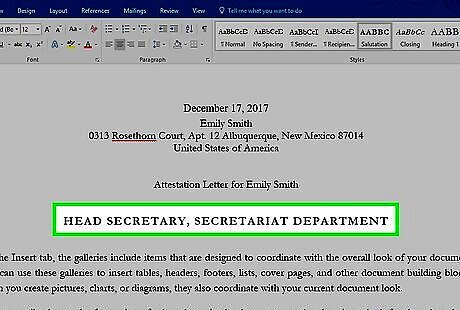
Address the letter to the appropriate individual or entity. Typically, you don't need to start with the word "Dear" in the salutation of a formal business letter. Simply type the name of the individual or department that will receive the letter. For example, if you are writing an attestation letter certifying that you have met the continuing education requirements for a license, you might address it "Licensing Board" followed by a colon. Use the name of the specific department or board when possible, rather than addressing it "To Whom It May Concern." If you're writing an attestation letter on behalf of another individual, such as a former employee, try to address it to the recipient by name if at all possible.
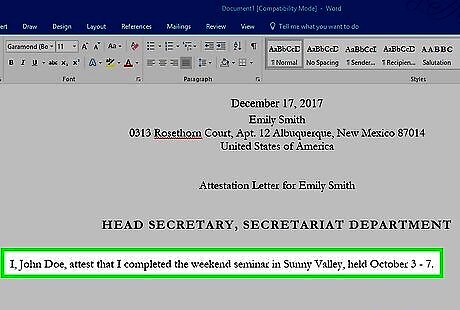
Introduce yourself if appropriate. Particularly if you're writing an attestation letter on behalf of someone else, use the first paragraph of your letter to explain who you are. Include your relationship to the person and any applicable certifications you have. For example, if you're writing an attestation letter for a former employee, you might begin by describing your job title in the company and how long you've been working there. If you're writing the letter for yourself, you may not need any introduction other than your name. For example, you might write "I, Sally Sunshine, attest that I completed the weekend seminar in Sunny Valley, held October 3 - 7." For that sort of attestation letter, the body of the letter typically would only be a sentence or two.

Identify the person for whom you're writing the letter. If you're writing an attestation letter on someone else's behalf, you should provide their name shortly after you've introduced yourself. You may choose to include it in the first sentence, then continue to introduce yourself. For example, if you were writing an attestation letter for a former employee, you might write: "I am Holly Henderson, president of Henderson Motors. I am writing to attest to Sally Sunshine's mechanical expertise."
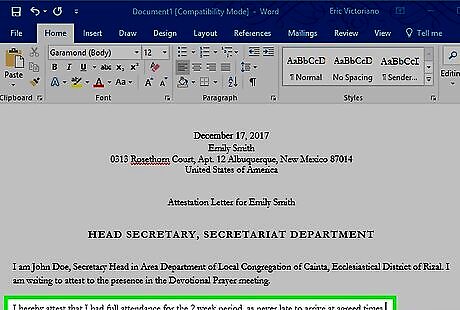
Provide the facts or information to which you attest. The bulk of the body of your letter is made up of whatever information you want to certify through the letter. Depending on your reasons for writing, this may be a sentence, or it may stretch to several pages. Stick to the facts, and keep your writing as clear and concise as possible using active voice.
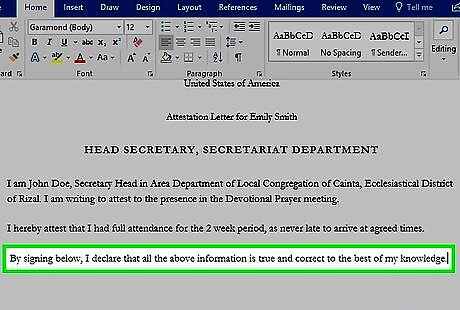
Include a declaration if you're writing the letter for yourself. If you're writing your letter to an organization or entity to certify something about yourself, you typically close your letter with a statement that everything in the letter is true and correct to the best of your knowledge. For example, your last sentence might read: "By signing below, I declare that all the above information is true and correct to the best of my knowledge." This type of declaration is especially important if you're planning on getting your signature notarized.
Finalizing Your Letter

Proofread your letter carefully. The spelling and grammar in an attestation letter can effect how your letter is received. If it has numerous typos and errors, the recipient may not take it seriously. Check your facts as well. When you sign your letter, you'll be certifying that everything in it is true. Double check any numbers, dates, and other figures to make sure they're accurate.
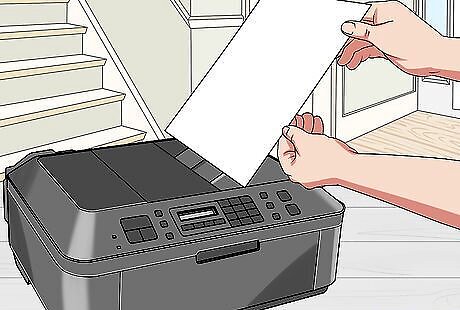
Print your letter. If you're mailing your letter, print it on official letterhead or high-quality paper. Avoid using regular copy paper, which can make it look less formal. If you don't have any high-quality paper, you can get a small box at your local office supplies store. Make sure the letter printed cleanly, and the margins are adequate. There should be at least 1 inch (2.5 cm) on all sides of the page. If your letter is more than one page, make sure the pages are numbered. Using "1 of 2" format will help the recipient confirm they have all of the pages.

Sign your letter in front of a notary, if necessary. It isn't always necessary to have an attestation letter notarized. In many cases, just your signature will suffice. Contact the recipient to find out if notarization is necessary. Notarization typically is required if the attestation letter has legal significance. For example, if you are sending an attestation letter to certify that you've met the requirements for a professional license, notarization may be required.
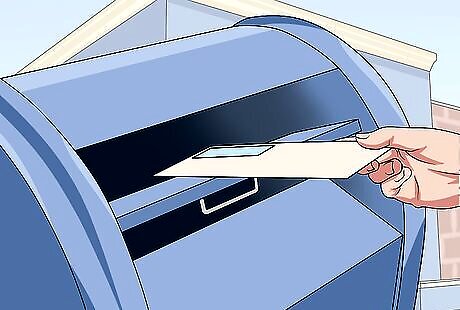
Send your letter to the recipient. You may have to reach out to the recipient to find out their preferred method of receiving your attestation letter. For such a formal document, you want to mail it if at all possible. However, some recipients may prefer email or fax. If you're emailing your attestation letter, print it and sign it first. Then scan the original document so you can attach a PDF of the signed letter.




















Comments
0 comment